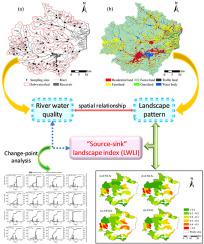Environmental Pollution ( IF 7.6 ) Pub Date : 2022-09-27 , DOI: 10.1016/j.envpol.2022.120287 Wanqing Yu 1 , Jing Zhang 1 , Lijuan Liu 1 , Yan Li 1 , Xiaoyu Li 1

|
Optimizing landscape pattern to reduce the risk of non-point source (NPS) pollution is an effective measure to improve river water quality. The “source-sink” landscape theory is a recent research tool for landscape pattern analysis that can effectively integrate landscape type, area, spatial location, and topographic features to depict the spatial heterogeneity of NPS pollution. Based on this theory, we quantitatively analyzed the influence of “source-sink” landscape pattern on the river water quality in one of the most intensive agricultural watersheds in Southeastern China. The results indicated that the proportion of “sink” landscape (68.59%) was greater than that of “source” landscape (31.41%) in the study area. In addition, when elevation and slope increased, the “source” landscape proportion decreased, and the “sink” landscape proportion increased. Nitrogen (N) and phosphorus (P) pollutants in rivers showed significant seasonal and spatial variations. Farmland was the primary source of nitrate nitrogen (NO3−-N) and total nitrogen (TN) pollution, whereas residential land was the primary source of ammonium nitrogen (NH4+-N) and total phosphorus (TP) pollution. Intensively cultivated areas and densely inhabited areas degraded water quality despite high proportions of forest land. The four “source-sink” landscape indices (LWLI, LWLI'e, LWLI's, LWLI'd) had significant positive correlations with NO3−-N and TN and weak correlations with NH4+-N and TP. The capacity of LWLI to quantify the NPS pollution was greater in agricultural areas than in residential areas. The “source-sink” landscape thresholds resulted in abrupt changes in water quality. When LWLI was ∼0.35, the probability of river water quality degradation increased sharply. The results suggest the importance of optimizing the “source-sink” landscape pattern for mitigating agricultural NPS pollution and provide policy makers with adequate new information on the agroecosystem-environmental interface in highly developed agricultural watersheds.









































 京公网安备 11010802027423号
京公网安备 11010802027423号